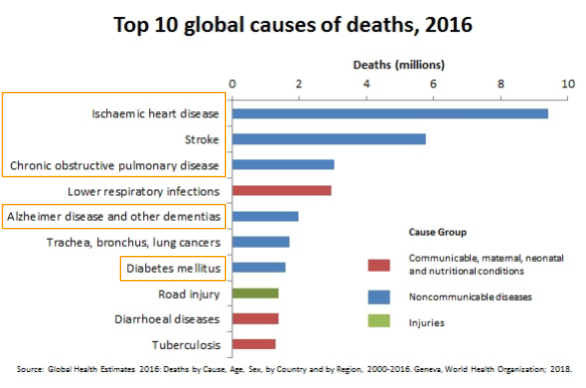NMN Anti-Aging Effect on MicroRNAs
NMN makes changes to micro ribonucleic acids (miRNAs), with evidence demonstrating this slows aging. This phenomenon is a promising topic for investigation of NMN use in humans . The changes in disease-gene miRNAs are predicted to epigenetically rejuvenate DNA expression.
A study funded by the American Heart Association at Reynolds Oklahoma Center on Aging demonstrated mice treated with NMN for two weeks had different micro ribonucleic acid (microRNA or miRNA) ‘fingerprints’. These miRNAs targeted genes for intracellular signalling, protein balance, and inflammation. The changes in miRNAs were tested in the main artery of the heart and were thought to rejuvenate DNA expression (epigenetic rejuvenation), resulting in phenotypically younger mice with fewer indicators of developing cardiovascular diseases.
The WHO listed three different vascular diseases as the top causes of death worldwide. Lower on the list of ‘top ten killers’ were other diseases correlated with circulation problems: alzheimer’s disease/dementia and diabetes mellitus. Many of these diseases are correlated to age, a time when miRNA profiles change.
MicroRNAs (miRNAs) are molecules shown in previous studies to correlate with vascular aging and mammalian lifespan extension. Abnormal behavior of miRNA gives the appearance (phenotype) of vascular aging, causing narrowing of the blood vessels (atherosclerosis) and preventing the formation of new blood vessels (angiogenesis). Understanding the molecules involved with vascular aging will help scientists create new treatments and prevent age-related vascular diseases

Three groups of mice were compared: young, aged, and aged with NMN. Older mice were injected twice daily with NMN (500mg of NMN per kg of body weight). The mice aortas were collected, pure RNA was extracted and quantified using real time polymerase chain reaction (q RT-PCR). 500 mg/ kg was the chosen because a similar dosage of NMN had anti-aging effects and made mice live longer (increased longevity) 1
Analysis of miRNA differences between groups showed a statistically significant number of miRNAs targeted genes involved in intracellular signalling, balance of proteins, and inflammation. Changes in disease-gene miRNAs were causally linked to fatty plaques in the arteries (atherogenic), so changes to the corresponding miRNA were predicted to rejuvenate DNA expression (epigenetic rejuvenation). The results predicted regulatory effects of miRNAs (Table 2 in the study) corroborating the anti-aging effects of NMN .
“Analysis of the differentially expressed miRNAs indicated that a statistically significant number of them had target sites within genes associated with pathways regulating the intracellular signaling, protein homeostasis, and inflammation (Table2). The results are consistent with the predicted anti-aging effects of NMN treatment.”
The study demonstrated some age-related changes in miRNAs can be reversed. This corroborates previous knowledge which indicated NMN restores NAD+ and has anti-aging effects on the cardiovascular system, reversing dysfunction in the lining of blood vessels (endothelium), reducing oxidative stress and improving mitochondrial function123.
“Our study demonstrates that protective effects of NMN treatment on vascular function is associated with anti-aging changes in the miRNA expression profile in the aorta in a mouse model of aging that recapitulates vascular alterations and deficits present in elderly humans at risk for cardiovascular and cerebrovascular diseases.”
The study concluded the protective effects of NMN on the cardiovascular system are “ anti-aging changes in the miRNA expression profile. Because the pathways were conserved in mice and humans this could translate to changes and deficits in elderly humans who develop cardiovascular and cerebrovascular diseases. NMN changes the miRNAs in a way that is anti-aging, and future studies will surely explore NMN’s on humans.
Future studies might uncover how miRNA gene regulation works in the anti-aging effect of NMN. These studies could also uncover links between miRNAs, NMN and sirtuin activators, how they act on ‘conserved’ pathways of senescence and age-related vascular disease. Through more research we will elucidate the anti-aging potential of NMN.

